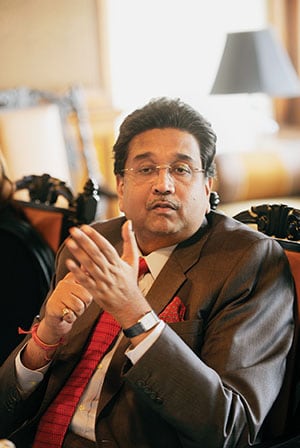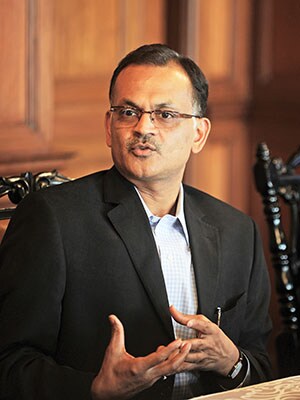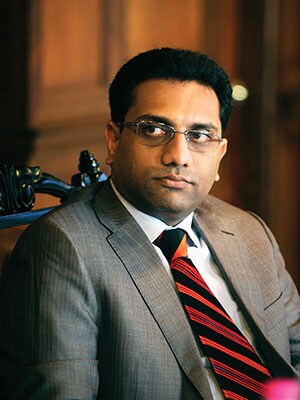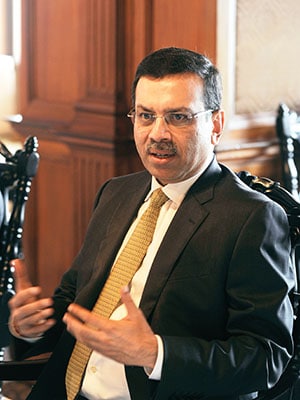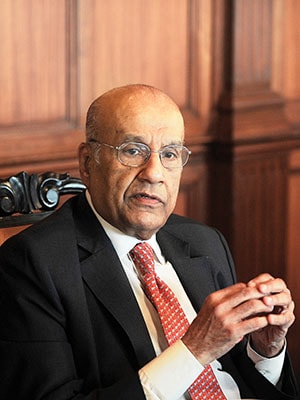
'Achchhe din' no longer mere rhetoric: Indian entrepreneurs bullish about economy
Hope floats as India's leading entrepreneurs say they are willing to put their money on an economy on the cusp of a likely turnaround
Achchhe din is no longer mere rhetoric. Prime Minister Narendra Modi has taken many steps to encourage investments, both domestic and foreign, and help kick-start the Indian growth engine. That is just on the face of it. What do those in the thick of action make of this rebooting of the economy?
In the seventh Forbes India CEO Dialogues, our first in Kolkata, we invited leading Indian entrepreneurs who have invested in diverse sectors: From fertilisers and power to real estate and cement to hospitality and consumer goods to retail. The thrust of the discussion was: “Will there be a revival in the domestic investment cycle?” Our panelists: Sanjiv Goenka, chairman, RP-Sanjiv Goenka Group; Saroj Kumar Poddar, chairman, Adventz Group; Harshavardhan Neotia, chairman, Ambuja Neotia Holdings Pvt. Ltd; Prashant Bangur, director, Shree Cement Ltd; and Hemant Kanoria, chairman and managing director, Srei Infrastructure Finance Ltd.
They reflected the current optimism, but also raised specific concerns regarding bureaucratic delays and reticence, procedural hurdles as well as the proof of the pudding argument. Excerpts from a lively discussion, moderated by Sourav Majumdar, editor, Forbes India:
Sourav Majumdar: A new government has come in—does this mean we will see a definitive change in the way we do business? Is there a green shoots theory at all and when will the investment cycle begin moving in India?
Saroj Poddar: India had enjoyed for a decade (till 2012) the fastest growth rate of the economy. During this period, its poverty was reduced by half. A vast majority of our population is poor and to remove them from poverty, we need a high rate of growth in the economy.
There is no doubt that after a change of government, there is tremendous impact on the business confidence index. As per a recent Ficci survey, the business confidence index has gone up to 72, which is the highest in the last 15 quarters. Today, companies are able to raise finances, go to global equity markets and raise capital not just on the strength of their current business model, but also on the confidence and perception that business in India will grow.
We have to see this convert to a ground reality. Fundamental issues holding this up include GST (Goods and Services Tax), interest rates, the land acquisition policy, the Companies Act, etc. These are some of the obstacles for doing business in India and they need to be corrected.
Some people in the government have raised our concerns on these issues and indications have been that they want to iron them out. The question is when. That is the key question. I am confident that this government will deliver. Reforms do take time, we have to be patient. The government does not enjoy a majority in the Rajya Sabha, so it’s bound to take time. But I am confident that we are moving in the right direction and investment growth in India will accelerate.
Majumdar: Mr Goenka, you have investments in the power sector. Do you share Mr Poddar’s optimism that things are now moving in the right direction? There are still hurdles on the ground. What is your take on when these will be cleared?
Sanjiv Goenka: For the first time in many years, the industry is beginning to plan to invest. From then [the planning] till the time you [actually] invest, there can be a time lag of 12 to 24 months depending on the industry. But for the last five years, nobody even thought of investing. Now you see people rethinking investment and the capital markets are buoyant. There are some issues that Mr Poddar has raised but, having said that, the confidence is that these will get addressed. We are now seriously planning for it [investments] in our group (RP-Sanjiv Goenka Group): The question is which sector and how much.
Suddenly solar and wind appear to be a great option; thermal too with the de-bottlenecking of the coal sector. For the first time, we are seeing not just hope, but also confidence. Speaking for myself, yes, we are looking at the next phase of investment. A year ago, we would have said just wait and watch, but not now.
Majumdar: So the wait-and-watch period is gone; it’s now time to plan and commit serious money. Do you think so, Mr Neotia?
Harshavardhan Neotia: I think so except that I would say this would vary quite considerably from industry to industry. I would also say that there are many industries where there is a lot of unutilised capacity still left to explore. In fact, with a little de-bottlenecking, I believe 25 to 30 percent more production can be achieved by everybody. The first round of growth can be attained by sweating existing assets. That will free up more money.
Since the economic environment was tough and interest rates were high, industries burnt up a lot of cash. Thus, they are not as liquid as they were four years ago. I would assume that at least 60 percent of industries would be in a difficult cash situation due to underutilisation of assets. In the real estate sector, there is so much built-up stock lying all over the country. This means prices are not escalating. The existing inventory has to first get used up and that’s going to take a while. There is optimism, certainly a feeling that going forward we are looking at ‘achchhe din’, but it’s going to vary across industries.
Majumdar: Mr Kanoria, you are in a sector which is critical for growth. In infrastructure, there have been many problems and they need critical attention. Do you subscribe to this view that there is a clear direction in which we are moving ahead?
Hemant Kanoria: Strategically, people had lost interest in India. In the last five months, Narendra Modi has been able to instil confidence in the World Bank and others that there is a need and reason to invest in India—that things are not in a mess. Pension funds, investors in stock markets, etc, have begun investing. Yes, people haven’t started investing in large measure through FDIs, whether in manufacturing or infrastructure. That will take some time because those who are looking at investments in infrastructure or manufacturing first assess whether the problem on the ground has been addressed or not.
Majumdar: What about domestic investment?
Kanoria: On that front, capital investment has just vanished. There is a serious cash crunch. People who had invested in infrastructure are half-stuck. There are, indeed, multiple hurdles at the ground level and they need to be systematically removed or else things won’t move. We spend hours in boardrooms, at the end of which we are exhausted because nothing eventually gets discussed. Time gets wasted on complicated taxation procedures and corruption issues. Income tax offices are being given targets, so they are slapping notices in an ad hoc fashion—they want to catch hold of defaulters every day.
Similarly, banks are stuck with NPAs and, in this regard, you can’t just import ideas from the US related to bankruptcy laws. Banks are told that the clients need to be taken to CDR (corporate debt restructuring). We are in the infrastructure sector, almost 70 percent of our clients—whether construction or infrastructure companies—have been taken to CDR.
Now, CDR is a big joke. The banker is like a doctor who does not know what to do with the patient. Therefore, he takes him to the ICU, keeps him there for a couple of weeks or maybe three months and then takes him out. But he has not done anything with the patient because he really does not know what to do. The outsiders are watching since the patient is in the ICU. He has not been given saline, medicines, surgery, nothing. So how will the patient get well? That is what the CDR is all about. The banks’ books look well for some time, but then they face the problems again. If they support the same promoter, there is the fear of vigilance. They fear the CBI will be after them. They can’t substitute [the promoter] because that is again a long-drawn process. Someone needs to address this problem, otherwise it’s going to blow up in everyone’s face.
The other problem is of the Rs 5 lakh crore worth of outstandings from state and centre to construction companies and contractors. These contractors, consequently, don’t have the cash flow, so they can’t pay banks. They can’t get new contracts because, due to lack of money, they can’t execute them.
Also, banks will not give them guarantees to gain new contracts. That has resulted in very few bidding for national highways: People don’t have money. If these issues are addressed, things will move. Else you will just see big intent, announcements being made, but no change on the ground. In the last four to five years, we have had too many Acts, now we need clear action.
Neotia: And this fear of the vigilance has led to bureaucracy going into a freeze. Any government person who is likely to be interrogated is holding back his decisions.
Majumdar: Isn’t that improving now and freeing up a bit? Isn’t bureaucracy now being empowered to take decisions?
Kanoria: Not yet. They still have the fear because some CBI inquiries have been restarted, so there is a fear.
Neotia: This is a structural issue which needs more thought. The fact that the CAG (Comptroller and Auditor General of India) brought up startling numbers to indicate possible loss to the government has made bureaucrats think that if you earn anything by regular action, it can also be seen as corruption. Five years later, when CAG audits it, they can say that this person earned so much in this deal, so he must have been corrupt. So why will the bureaucrat accept any deal or contract?
Poddar: I think with the new legislation that was being put up in Parliament, there is some provision to the extent that bureaucracy will be protected. It’s only for the coal ministry right now, but it’s a start. The government is indeed thinking about it.
Kanoria: There is a fabric of mistrust prevalent right now. This needs to be changed. How the government will change it is a concern.
Neotia: The mood prevalent is that business is not to make money. What kind of logic is that?
Poddar: Honestly, I am not so pessimistic. The prime minister completely accepts the fact that private initiative is for profit. And he encourages that. And he is interacting with bureaucracy personally which will correct this problem. It will take time, but it will get resolved.
Majumdar: Mr Bangur, you are in a sector which is directly linked to the pace of growth of the economy. Are you looking at some freeing up there or do you also subscribe to the views expressed here?
Prashant Bangur: I am not very optimistic about how soon the investment cycle will begin to turn around. What we experienced in the last few years were two deaths in quick succession: One was the coal scam and the other was the telecom scam. They killed the sentiment of the industry and entrepreneurs.
On the demand side, two factors can turn around the situation: One will be the push factor, and the other is the pull factor. Due to the sentiment of the last few years, there isn’t much happening on the push side. There is overcapacity in every sector you can imagine. India is no longer a shortage economy. When it comes to the pull factor, the government has to play a role. It has to create excitement and incentivise because the Indian consumer is in a state of mourning.
The macroeconomic indicators are at the cusp of where things will start moving very soon. But we need some sort of a stimulant—it may be fiscal, it may be through policies, it may be in the direction; some incentive is required to cajole entrepreneurs to start investing.
Majumdar: The government has recently launched the Make In India initiative. How important will it be in reviving the investment cycle?
Poddar: India has certainly lagged behind in manufacturing. Today our biggest competitor is China. Although we are far more competitive in terms of wages when compared to China, there is still a long way to go. The Make In India initiative has helped bring the focus back to manufacturing.
Goenka: It is part of rebuilding the confidence within and outside India. In that sense, it’s brilliant. Going forward, we also need a few other things to fall in place, to make India worthwhile for investment. It’s a good signal that we mean business, that we want people to invest in India.
Bangur: Earlier we did think of investing abroad. However, now, we have changed our focus from investing in South Asia to back in India due to this initiative and other moves that the government has made. We [Shree Cement] are investing in the eastern part of India also: We are coming up with a plant in Bihar and also in Raipur (Chhattisgarh). The Make In India campaign is good, but we need to realise who are we making for—is it for export or for India itself? It’s a global market now, so companies who have the expertise need to be allowed to come and invest here—Indian entrepreneurs may or may not have the expertise to make the best product at the cheapest price point. Also, the manufacturing sector can employ a lot of people and that will boost consumption.
Kanoria: Make In India will not succeed unless we look into specifics. What do we want to be made in India, and where will overseas companies have an advantage compared to China or other countries? Post that analysis, respective industrial parks need to be created to facilitate that type of manufacturing. If land acquisition is still an issue, then that needs to be resolved. How do we attract overseas investors to come and make in India? You can’t just open up the market and expect investors to buy their own land, arrange for electricity and run for all the clearances.
Majumdar: The other industry that India was waiting to be opened up was defence and also railways. Do you think freeing up of these sectors will play a catalysing role for investments to flow in?
Goenka: Clearly that is going to be a very big trigger. Speaking for myself, we are tightening our belts and getting ready to invest. And we will invest big time.
Poddar: These are ready markets to tap into. And it resonates well with the prime minister’s Make In India campaign. The Japanese have been invited to build the bullet train project, for instance, which is an entry point for international companies in this sector. And if these sectors come up, Indian industry will also participate in it. If there is an opportunity under the railway privatisation and modernisation programme, then we [Adventz Group] will certainly be willing to invest. In fact, we have already signed a joint venture with Westinghouse to get into this.
Majumdar: When the investment cycle picks up, which are the sectors that will drive it?
Goenka: I think it will happen in many sectors, clearly in the railway and defence sectors and in the infrastructure sector—be it power, cement, steel, in different periods and over the years. We are also seeing consolidation take place across sectors which means someone is investing and adding capacity. It might not be greenfield—it is, in fact, brownfield—but capacity is being added nonetheless. In the last five years, you hardly heard of people acquiring large assets within India, but it’s happening now since there is confidence in the future. We had five years of complete inertia and it won’t reverse overnight. The process has begun, the intent is firm. There are still issues to be resolved, but one will see significant moves from here on.
Neotia: One sector that is a low-hanging fruit is tourism. With airport infrastructure having improved in our country, visa on arrival being announced for a lot of countries and hotel capacities being much higher than ever, we are best placed to make a difference there. We need a perception change that we are a great hospitable place to visit. Just like one campaign by Amitabh Bachchan helped triple tourism for Gujarat, we need such a campaign for India too. The opportunity for India, much like it happened in mobile telephony, to leapfrog is huge, and with very little effort.
Poddar: Logistics and food processing are also important sectors. We kept talking about it for so many years. This can help limit food wastage and will have a major impact in rural India.
Kanoria: Food processing industries indeed have a huge potential. There is considerable local demand. We don’t have enough cold chains, silos and warehouses. Wheat is still lying in Haryana and Punjab on the airfield, and it is getting rotten and wasted.
Poddar: In one of our companies, as part of our social commitment, we built 500 toilets but, to our surprise, 300 of them were used for storage of foodgrains. The situation is that grave for food storage in rural areas.
Majumdar: Can I ask each one of you to share your broad investment plans for the near future and the rough time horizon?
Goenka: Over the next three to five years, we would be looking at doubling our asset base, going from over Rs 29,000 crore currently to Rs 50,000-60,000 crore. And we will invest across all sectors.
Neotia: I am looking at hospitality, tourism, health care and real estate. My asset base would be very small, around Rs 2,000-3,000 crore. I am also looking at doubling the asset base in the next five years.
Poddar: In terms of revenues, our group is at about $3 billion today. I certainly expect it to reach closer to $5-6 billion over the next five years.
Kanoria: We have a total book size of Rs 90,000 crore today in infrastructure and we see clear opportunities in expanding the loan book as also our current portfolio. At this juncture, we see an opportunity for acquisitions, whether it be roads, power, ports or SEZs. In the next two to three years, we should be able to at least take our asset base to one-and-a-half times or double it.
Bangur: Shree Cement right now is an 18 million tonne company. We will be in a position to be around 35 million tonnes in around five years, or by 2020.
Majumdar: This alone should give Mr Narendra Modi some confidence and comfort that despite all the problems we have talked about, corporates and entrepreneurs are actually committing growth numbers. That’s probably the change he has brought about.
(This story appears in the 30 November, -0001 issue of Forbes India. To visit our Archives, click here.)


